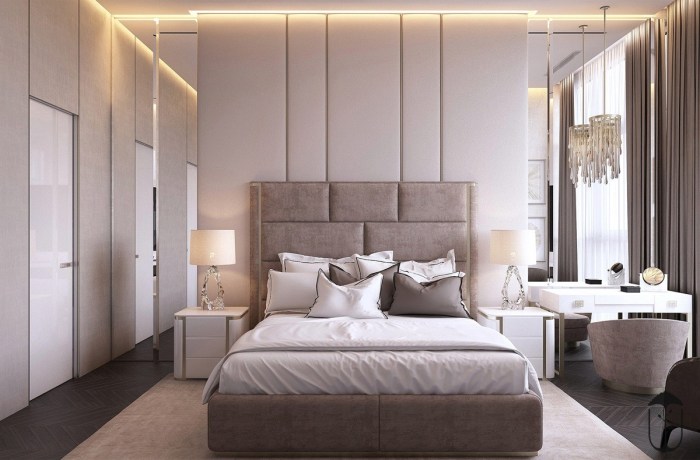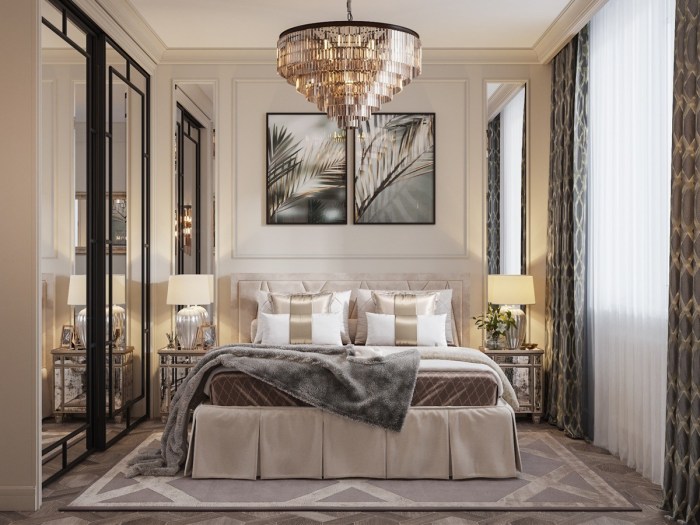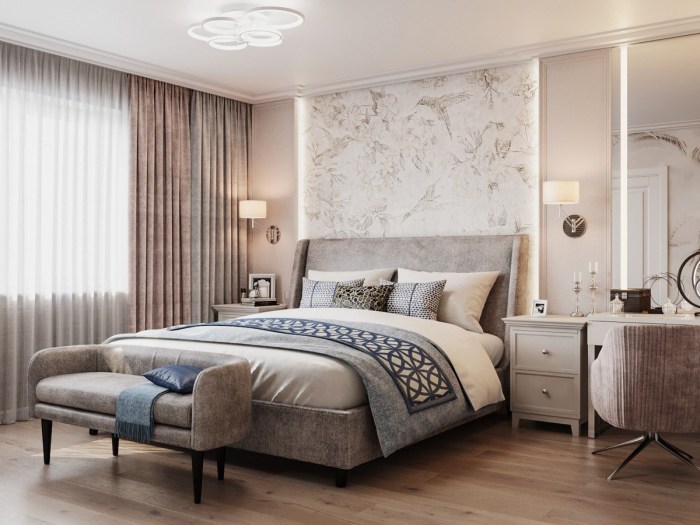In the realm of interior design, the fusion of modern and traditional styles has emerged as a captivating trend, offering a harmonious blend of classic elegance and contemporary flair. Transitional bedroom design embodies this concept, creating spaces that are both timeless and inviting.
This design approach embraces the best of both worlds, seamlessly integrating the clean lines and minimalist aesthetics of modern design with the warmth and comfort of traditional elements. By carefully balancing these contrasting styles, transitional bedroom designs achieve a sophisticated and inviting ambiance.
Design Principles for Blending Modern and Traditional Styles
Incorporating elements from both modern and traditional design styles can create a cohesive and visually appealing space. Understanding the key principles of each style and how to harmonize them is essential for a successful blend.
Modern design emphasizes clean lines, simplicity, and functionality. Traditional design, on the other hand, often incorporates intricate details, ornate patterns, and a focus on comfort and warmth.
Balance
Balancing elements from both styles is crucial. Avoid overwhelming the space with too much of one style. Incorporate modern pieces with traditional accents or vice versa to create a harmonious equilibrium.
Scale and Proportion
Consider the scale and proportion of furniture and decor. Oversized modern pieces can overwhelm a traditional space, while delicate traditional pieces can get lost in a modern setting. Choose pieces that complement each other in terms of size and shape.
Color Palette and Patterns
When blending modern and traditional styles, the color palette plays a crucial role in achieving a harmonious balance. Neutral tones, such as white, cream, beige, and gray, provide a timeless foundation and allow both modern and traditional elements to coexist seamlessly.
To add visual interest, accent colors can be incorporated. Consider using bold hues like navy blue, emerald green, or mustard yellow to create a modern touch. These accents can be applied to walls, furniture, or textiles to draw the eye and add a touch of sophistication.
Patterns
Patterns are another effective way to blend modern and traditional aesthetics. Geometric patterns, such as stripes, chevrons, and polka dots, add a modern flair, while floral, damask, and toile patterns evoke a more traditional ambiance. By mixing and matching different patterns, you can create a visually dynamic space that combines the best of both worlds.
For example, a traditional floral wallpaper can be paired with a modern geometric rug to create a striking focal point. Alternatively, a modern sofa upholstered in a neutral fabric can be complemented by traditional throw pillows with intricate patterns.
Furniture Selection and Arrangement
Blending modern and traditional styles in furniture selection and arrangement requires careful consideration. The goal is to create a harmonious space that combines the best of both worlds. Here are some tips to help you achieve this:
Furniture Selection
- Choose pieces with clean lines and simple silhouettes for a modern touch.
- Incorporate traditional elements such as carved details, turned legs, or antique finishes.
- Mix and match different materials like wood, metal, and leather to add visual interest.
- Consider scale and proportion to ensure furniture fits well within the space.
- Prioritize functionality and comfort, selecting pieces that meet your needs and lifestyle.
Furniture Arrangement
Once you have selected your furniture, arrange it to create a cohesive and inviting space:
- Define the focal point of the room, such as a fireplace or a large window.
- Arrange seating areas around the focal point, creating conversation zones.
- Use rugs to define different areas and add warmth.
- Balance traditional and modern elements throughout the space, ensuring neither style dominates.
- Leave ample space for movement and avoid overcrowding the room.
Lighting and Decor
The lighting and decor in a transitional bedroom design play a crucial role in creating a harmonious blend of modern and traditional elements. By incorporating both natural and artificial lighting effectively, you can achieve a warm and inviting atmosphere that complements the overall design scheme.
Lighting
Natural light is essential for any bedroom, as it provides a sense of spaciousness and well-being. Large windows or skylights can flood the room with natural light, creating a bright and airy ambiance. Artificial lighting, on the other hand, can be used to create a more intimate and cozy atmosphere when natural light is not available.
For artificial lighting, consider using a combination of ambient, task, and accent lighting. Ambient lighting, such as a chandelier or recessed lighting, provides general illumination for the entire room. Task lighting, such as bedside lamps or reading lamps, provides focused light for specific activities like reading or working.
Accent lighting, such as wall sconces or picture lights, highlights architectural features or decorative elements, adding depth and character to the space.
Decor
The decor in a transitional bedroom should reflect the personal style of the homeowner while complementing the overall design scheme. Traditional elements, such as antique furniture, classic artwork, and luxurious fabrics, can be combined with modern pieces, such as sleek lines, geometric shapes, and minimalist designs.
When selecting decor items, consider the scale and proportion of the room. Oversized pieces can overwhelm a small space, while small items can get lost in a large room. Choose pieces that are visually appealing and add character to the space, such as artwork, throw pillows, and decorative objects.
Creating a Focal Point
In a transitional bedroom design, creating a focal point is crucial to draw attention and enhance the overall aesthetic. This point of interest serves as a visual anchor, guiding the eye and adding depth to the space.
To establish a focal point, consider incorporating artwork, an accent wall, or a statement piece. Artwork, such as a large painting or a series of framed prints, can instantly command attention. An accent wall, painted in a bold hue or adorned with wallpaper, creates a dramatic backdrop.
Statement pieces, like a canopy bed or a unique headboard, add a touch of grandeur and become the centerpiece of the room.
Positioning
The positioning of the focal point is equally important. It should be placed in a central location, such as the headboard wall or the opposite wall from the bed. Avoid cluttering the space around the focal point, allowing it to stand out and create a sense of balance.
Incorporating Technology
In a transitional bedroom design, technology plays a crucial role in enhancing both functionality and aesthetics. By seamlessly integrating smart devices, lighting controls, and other technological advancements, you can create a space that is both stylish and technologically advanced.Integrating technology into a transitional bedroom design requires a thoughtful approach to ensure that it complements the overall aesthetic rather than overpowering it.
Smart devices, such as voice assistants and smart plugs, can be used to control lighting, music, and other devices hands-free, creating a convenient and modern touch. Lighting controls, such as dimmers and color-changing bulbs, can be used to create the perfect ambiance for relaxation or work.
Closing Summary
Transitional bedroom design is a testament to the power of blending different eras and styles to create a space that transcends time. By embracing the principles of balance, proportion, and harmony, homeowners can craft bedrooms that are both aesthetically pleasing and effortlessly functional.
Whether you seek a serene retreat or a stylish sanctuary, the fusion of modern and traditional elements offers endless possibilities for creating a bedroom that reflects your unique personality and style.



